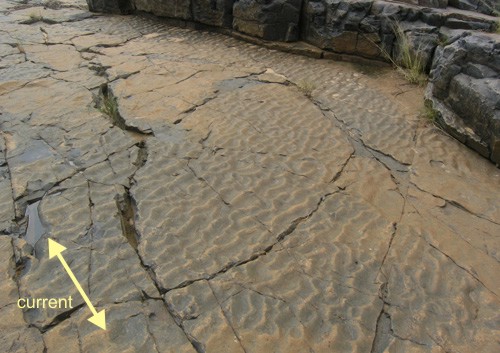Last week’s geopuzzle was really just an excuse to show off more photos of the rather nice sedimentary structures preserved in the Archean rocks I visited the other week. All of the photos show preserved ripple marks. I’ve always found it difficult to picture how turbulent river and tidal currents always manage to produce these lovely regular structures; it seems that I’m not the only one, as apparently modelling these things is pretty hard. Nonetheless, you can get a lot of environmental information from these bedforms:
- Type of current – constant, unidirectional currents tend to form ripples with a steep side facing in the direction of flow, and a shallow side facing away from the direction of flow. In tidal environments, where you get oscillating back and forth currents generated by waves, the ripples tend to be much more symmetrical in form.
- Current speed – long straight ripple crests tend to indicate slightly slower current speeds than shorter, sinous ones. I assume (but am not certain) that this is something to do with increasing turbulence as the water starts flowing faster.
I thought that the most obvious difference between the first two photos was that the ripple crests in the second photo are much more undulating in form. However, most commentators also picked up on an apparent difference in their symmetry – the first photo appears to have asymmetric ripples formed by a constant current flowing from right to left, whereas the second photo appears to show much more symmetrical ripples consistent with oscillating tidal currents. Looking again, I think y’all might be right.


The final photo, as I said at the time, was tricky. A couple of people noticed that there appear to be two sets of ripples, indicating different current directions, preserved on the same bedding surface:

These interfering sets of ripples are thought to be yet another example of the binding activity of those Archean bacterial mats: the idea is that mat growth stops earlier ripples from being completely reworked by later seasonal currents, which have a different direction. Of course, this implies that these ripples are also formed by the flow of water rather than being aeolian (wind-blown), as a couple of people thought. If this interpretation is correct, then these structures formed in the inter-tidal zone, so we’d expect them to be fairly symmetrical; what do you think?



Comments (1)